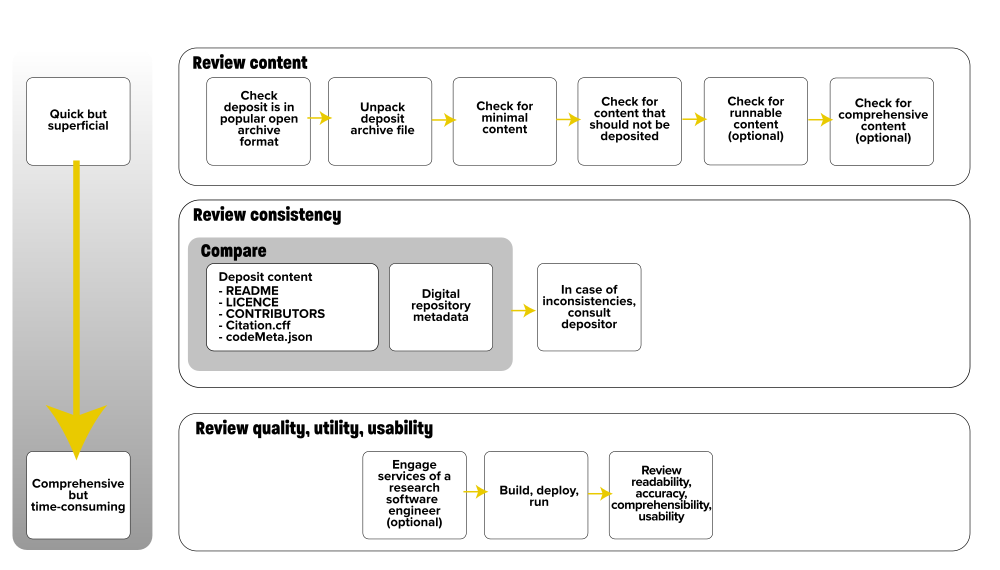


|

|
Version 1.0
Digital repositories can differ in the deposits that they accept, the metadata requested from researchers, how researchers make their deposits and how these deposits are processed. This includes how deposits are reviewed post-deposit and pre-publication and the criteria that are used in these reviews. Despite the differences between individual digital repositories, there are some common checks that can be done for any software deposit. The nature and degree to which a software deposit can be reviewed depends upon the time, effort and expertise you have available. This guide describes three approaches to reviewing a deposit: a quick content review, a more detailed consistency review and a comprehensive review of quality, utility and usability.

How to review a software deposit
This guide is one of a series of guides on software deposit, written by The Software Sustainability Institute 1, funded by Jisc 2. For an overview of the series, see Michael Jackson (ed.) (07 August 2018). Software Deposit: Guidance for Researchers (Version 1.0). Zenodo. doi:10.5281/zenodo.1327310. Online: https://softwaresaved.github.io/software-deposit-guidance/SoftwareDepositGuidance.html.
A content review has the advantage that it is quick to assess whether a deposit contains, or does not contain, content essential, or useful, for other researchers. However, the content review does not assess the quality, accuracy or consistency of these contents.
Check that the deposit is in a popular open archive format i.e. one of ".zip", ".tar", ".tar.gz", ".tgz", or ".tar.bz2". ".7z" or ".rar" should be avoided as support for these is not available by default in current versions of Linux, Windows or MacOS.
Unpack the deposit archive file to ensure that it has not been corrupted and can be unpacked successfully.
Check that the deposit includes the following minimal, essential, content:
Check that the deposit does not include the following files:
Check for the following content, if you want to check whether the deposit theoretically provides enough content to allow other researchers to build, install, configure and run the software on sample data:
Check for the following content, if you want to check whether the deposit theoretically provides enough content to allow other researchers to reuse, customise and modify the software and provides documentation allowing them to understand, in detail, both how the software implements the research and where it sits in its wider software ecosystem:
Your digital repository will collect metadata about the researcher's deposit. The researcher's deposit itself will include metadata. This review checks that the metadata as recorded within your digital repository is consistent with that recorded within the researcher's deposit.
Compare your digital repository's metadata to metadata in the following files in the deposit:
If there are any discrepancies or inconsistencies then it would be expected that the metadata within the deposit takes precedence and the metadata within your digital repository should be updated accordingly. However, if in doubt, consult the researcher who made the deposit.
A review of quality, utility and usability involves trying to build, deploy and run the software, following its user and developer documentation, reviewing these for readability, accuracy and usability. This review can help to determine whether another researcher could understand what has been deposited and whether they could replicate, reproduce and reuse the research, as manifested in the software, in the short term and inspect, for the historical record, in the long term, i.e., does the deposit now standalone as a useful resource independent of the researcher who deposited it. The disadvantage of such a review is that it requires a lot more time to do. It may require you to consult the services of a research software engineer.
Related Software deposit guides:
Source code and data files:
CodeMeta and codeMeta.json files:
Software citation and CITATION.cff files:
Please cite as: Michael Jackson (ed.) (07 August 2018). Software Deposit: How to review a software deposit (Version 1.0). Zenodo. doi:10.5281/zenodo.1327314. Online: https://softwaresaved.github.io/software-deposit-guidance/HowToReviewSoftwareDeposit.html.
 This work is published under a Creative Commons Attribution 4.0 International License (CC BY 4.0), https://creativecommons.org/licenses/by/4.0/.
This work is published under a Creative Commons Attribution 4.0 International License (CC BY 4.0), https://creativecommons.org/licenses/by/4.0/.
The Software Sustainability Institute, https://www.software.ac.uk.↩
Jisc, https://www.jisc.ac.uk.↩